Concept of e-Government
In short, e-Government (Government) is a modern, innovative, people-led government that operates more effectively and efficiently, providing better services on the basis of ICT applications.
1. The concept of e-Government
According to the World Bank (World Bank) definition: "e-Government is the use of ICT systems by government agencies to implement relations with citizens, businesses and social organizations. As a result, government agencies' transactions with citizens and organizations will be improved, improving quality, the benefits will be reduced corruption, increased publicity, convenience, and contribution. into growth and cost reduction ".
- United Nations definition : 'E-government is defined as the use of the Internet and the world-wide web to provide government information and services to citizens'.
- Definition of the organization Global business dialogue on e-commerce : 'E-government refers to a state in which executive, legislative and judicial agencies (including central government) and local governments) digitize their internal and external activities and use effective networked systems to get better quality in providing public services'.
- Gartner's definition : e-government is' the continuous optimization of service provision, electoral participation and management by changing internal and external relations through technology, Internet and new media '.
- The definition of e-Government Research Group in a developed world : 'E-government is the use of information and communication technology to promote government effectively and effectively, supporting access to government services, allowing greater access to information and making government accountable to citizens. E-government may include the provision of services over the Internet, phones, community centers, wireless devices or other communication systems. '
2. Electronic Government Functions
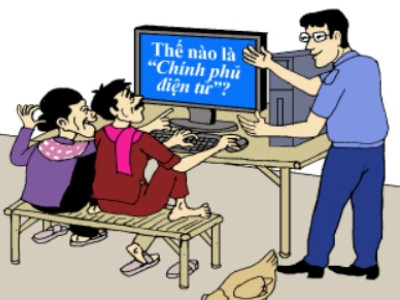
Although there are different concepts, it can be understood in a simple way: e-Government is the application of information-communication technology to the government agencies to innovate, work effectively, effectively and transparently. more, provide better information and services for people, businesses and organizations; and at the same time create more favorable conditions for people to exercise their democratic rights in participating in state management. In short, e-government is an effective, more efficient government, providing better services based on the application of information-communication technology.
Participating in e-government includes 3 subjects: people, Government and enterprises. Interactive relationships between 3 subjects include:
- G2C: Government relations with people.
- G2B: Government relations with businesses.
- G2G: Relating government agencies together.
The basic objective of e-government is to improve the process of working in government agencies through electronic administration, improve relations with citizens through e-citizens and proceed to build a knowledge society above. IT platform.
The development of e-Government undergoes a number of different stages. Depending on the stage (implementation and maintenance), the complexity increases, but the value for the people and businesses also increases (including increased for the Government through possible additional sources). indirect or direct).
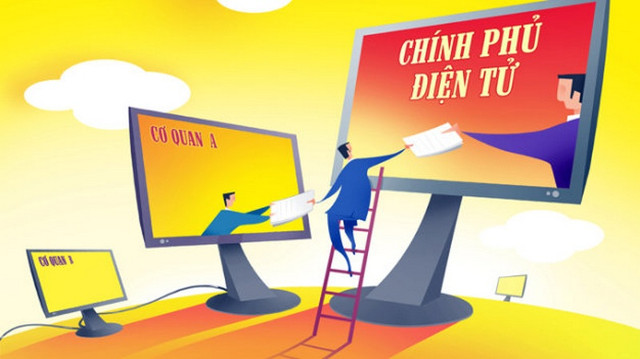
A model of e-government has been widely used, built by consulting and research firm Gartner, showing four stages (or periods) of e-Government development process.
- Information : in the first phase, e-Government means being present on the website and providing the public with information (appropriate). Value brought about by the public can access information of the Government, processes become more transparent, thereby improving service quality. With G2G, Government agencies can also exchange information with each other by electronic means, such as the internet or intranet.
- Interaction : in the second phase, the interaction between Government and citizens (G2C and G2B) is adopted through many different applications. People can exchange directly via email, using search tools, downloading forms and documents. These interactions help save time.
In fact, single-word reception can be done online 24 hours a day. Usually, these movements can only be done at the reception desk during office hours. Internally (G2G), Government organizations use LAN, intranet and e-mail to communicate and exchange data. It is clear that this phase can only be implemented when administrative reforms (with an electronic one door mechanism and an electronic one-stop shop mechanism) have been implemented in the spirit of Decision No. 93/2007 / QD-TTg. June 22, 2007 of the Prime Minister.
- Transaction : with the third stage, the complexity of the technology has increased, but the value of customers (in G2C and G2B) also increases. Complete transactions can be done without going to administrative agencies.
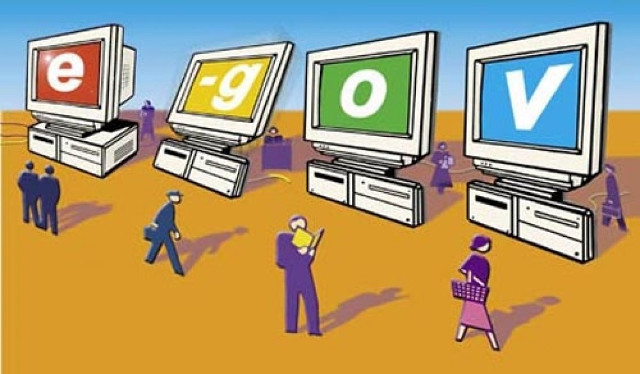
Examples of online services can be found such as: Income tax registration, property tax registration, renewal / grant of permits, visas and passports, online voting. Stage 3 is complicated by security and personalization issues, such as digital signatures (electronic signatures) that are necessary to legally deliver services.
In terms of business, e-Government starts with online shopping applications. At this stage, internal processes (G2G) must be redesigned to provide good service. The government needs new laws and regulations to allow transactions that do not use paper documents.
- Transformation : the fourth stage is when all information systems are re-integrated and public can enjoy G2C and G2B services at a transaction desk (virtual transaction point). At this stage, cost savings, efficiency and customer demand have achieved the highest possible levels.
Not necessarily every step of development and service must be at the same stage. Indeed, it is important to filter out some of the services that need to be brought into phase 2 and stage 3 and provide models of roles and motivations to move on.
Regarding the core issues of G2C and G2B, with G2C should focus on the initial stages of 1 and 2. However, with G2B, it is recommended to focus efforts on achieving phase 2 and phase 3 and the final destination the same is stage 4 (but this is a long-term goal of 10 to 15 years).
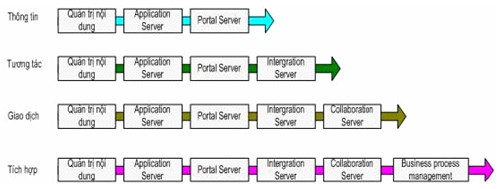
3. Goals of e-Government
The overall goal is to strengthen the capacity, improve the effectiveness of government governance, to bring about convenience for the people, enhance transparency and reduce government spending. Specific objectives are:
- Improving management capacity of the Government and government agencies at all levels (exchanging electronic documents, collecting accurate information and timely making decisions, electronic briefings .).
- Providing people and businesses with public services facilitates easy access for people everywhere.
- People can participate in policy formulation, contribute to the process of law-making, and the government's management process in a positive way.
- Reduce costs for the Government apparatus.
- Implement a modern, efficient and transparent government.
E-government will create a new leadership style, new methods, provide services to people and improve the capacity of managing and operating the country.
Therefore, in recent years, all countries have tried to invest in building e-government. Building e-government in Vietnam is an urgent requirement, it is an important part of the national administrative reform process.
Difficulties and obstacles in the process of building e-government in Vietnam are very much:
- Inadequacies from IT projects.
- ICT infrastructure is still weak.
- Low literacy levels.
- The level of awareness and skills of public officials is limited.
- Business process is not stable (in the process of reform).
Benefits of e-Government
- E-Government is a government that guarantees to provide adequate information and timely information for decision-making. Ideal e-government is a government that provides full information, timely for those who decide, which is the biggest advantage of IT.
- E-Government uses IT to automate the administrative procedures of the Government and apply IT to the management and operation processes of the Government. Therefore, the processing speed of administrative procedures is much faster.
- E-Government allows citizens to have access to administrative procedures through electronic means, such as: Internet, mobile phones, interactive television.
- E-Government helps businesses to work with the Government easily because every procedure is understood, guided and every work step is guaranteed to perform well and reliably. All economic information that the Government has, is fully provided for businesses to operate more efficiently.
For civil servants
- IT used in e-government is a tool to help them operate more effectively, able to meet the public's demand for information to access and process them.
- For people and businesses
- Minimize the time for citizens, businesses and workers to access and use government services and thus reduce people's costs. Encourage community participation in government activities.
For the Government
Reducing office-work-paper losses, saving time, streamlining work operations, allowing Government agencies to provide higher quality services and reducing the Government's spending budget covered.
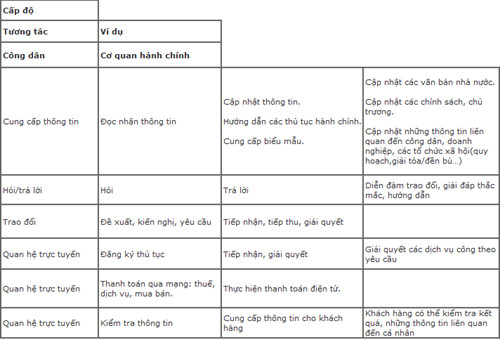
4. Trading models in e-Government
Participating in e-government has 3 entities: Government, people and businesses. Based on the relationship between the above entities, we can classify e-Government into 4 categories, corresponding to 4 types of Government services including:
G2C (Government to Citizens) : understood as the ability to trade and provide government services directly to people, for example: Election of citizens, public opinion exploration, construction planning management urban, consulting, complaints, supervision and tax payments, industry invoices with subscribers, 24/7 live information services, public service, educational environment.
G2B (Government to Business) : Government services and relations for businesses, non-governmental organizations, manufacturers such as: procurement, inspection and supervision services of enterprises (on tax payment, compliance) law enforcement, .); information on land use planning, urban development, bidding, construction; provide information in the form of documents, instructions for use, regulations, implementation of state policies, . for businesses. This is a fundamental component in the state model, which is the subject of economic and social macroeconomic management through policies, mechanisms and laws and businesses as the representative of the production force. direct material wealth of the economy.
G2E (Government to Employees) : refers to services, transactions in the relationship between the government for civil servants, insurance officers, employment services, unemployment benefits, health care, housing .
G2G (Government to Government) : understood as the ability to effectively coordinate, deliver and provide services between levels, sectors, organizations, and state apparatus in the administration and management of the state. , in which the government apparatus itself plays the role of subject and object in this relationship.
All government relations and transactions systems such as G2C, G2E, G2B, and G2G must be placed on a solid infrastructure of the system: trust, ability to ensure privacy (privacy ) and security - security (security) and ultimately all based on technology and communication infrastructure with different scales: computer network, Intranet, Extranet and Internet. In addition to the 4 main trading models in the table below, other forms of communication in e-government are shown.

5. Types of activities and types of services provided through e-Government
a. The main forms of e-government activities
- Email (e-mail)
Email saves money and time. E-mail can be used to send memos, notices, reports and newsletters. E-Government requires each public servant to have an e-mail address to exchange information online. Vietnam strives to reach 70% - 80% of documents and official documents transferred online.
- Public procurement in e-Government
Public procurement can be done online, ensuring time and cost savings. Centralized procurement will ensure cost savings and anti-negativity.
- Electronic data exchange
Electronic Data Interchange (EDI) is the exchange of data in a 'structured form' from one computer to another electronic device within the body or between muscles. mandarin EDI has high security.
- Look up and update information online
The government through the internet can provide information to people and businesses about economic and social information, policy guidelines, and guidelines for administrative procedures.
b. Types of services provided by e-government
- Government online public services:
In the past, government agencies providing public services to people at their headquarters can now provide public services online through electronic portals. People do not have to come directly and wait at the offices above as before.
Some public services that can be provided online include: Providing information on legal documents and policies: Providing economic, social and market information; Providing online registration and licensing services; Providing online tax declaration services; Provide online business registration service.
- GIS and services provided through e-Government
E-Government can use the Internet and GIS to provide many new services that people and businesses care about.
- Providing application services of GIS for land management, construction permits.
- Provide planning information services.
- Providing GIS application services to exchange information between agencies and authorities at all levels for resource management.
6. Criteria when it comes to e-Government
- Citizenship and easy to use.
- There is a sense of responsibility, one-door and directional results.
- Accessibility: People can access government service networks in many ways (at home, at work, at school, in public, etc.).
- Collaboration: e-Government must be designed, built and implemented on the basis of cooperation between the Government and individual citizens.
- Innovation: e-Government is not only about the application of new technology, the Web site or the delivery of services on the Internet, but also the improvement of the working process and organizational structure.
- Reasonable cost: Reduce costs for the Government apparatus.
- Safety and respect for privacy.
The above problems are about the entity of an e-Government (corresponding to the English word E-Government). Discussing the development of e-government, many international conferences and some countries also offer a concept that precedes the concepts of e-government mentioned above, which is the issue of 'e-government, or e-state administration' This concept is translated from English "E-Governance" .The word "Governance" is translated as "State management", but because the word "Management" we use sometimes means something different from the problem So, I would like to temporarily use the word "ruling", or "running state".
Going in this direction, we need to mention some issues, here, just name each issue:
- Methodology, technology or state-run technology.
- Good governance in relation to institutions and socio-economic structures.
- Innovating the way of operating, including the relationship between IT and telecommunications with good state management.
The role of the Government in the transition to digitalization: Building a knowledge society.
The role of the Government in enhancing authority, the role of individuals, communities and social organizations, as we often say: Enhancing people's ownership.
Solving the above problems, e-government is considered an opportunity for the government to improve itself, more closely linked with the people, with the interests of population groups, real more economical and for the nation's development.
E-State administration creates a new leadership style, new ways of discussing and deciding strategies, a new way of trading, in providing services to citizens, in training resources, in listen to the people and in organizing and providing information.
You should read it
- Lied to the US Government, Samsung was fined $ 2.3 million
- Australia sued Facebook for privacy violations, claiming up to $ 529 billion
- Spy virus attacks the Iranian Government
- The Peruvian government buys 40,000 laptops for elementary students
- Amazon restricts sale of N95 face masks, surgical gloves to the public
- Italy on the first day of blockade: Many people bypass the law by all means, despite the urgent call from the government
 How to enable Tor features in Firefox increases security when browsing the web
How to enable Tor features in Firefox increases security when browsing the web Sony achieved record sales for 20 years thanks to the talented Japanese 'captain'
Sony achieved record sales for 20 years thanks to the talented Japanese 'captain' What will your face actually look like when you look through Face ID?
What will your face actually look like when you look through Face ID? Everything you need to know about the latest Firefox comes out next week
Everything you need to know about the latest Firefox comes out next week Samsung released the next-generation processor - Exynos 9810
Samsung released the next-generation processor - Exynos 9810 Microsoft integrates LinkedIn with Word to make writing applications easier
Microsoft integrates LinkedIn with Word to make writing applications easier